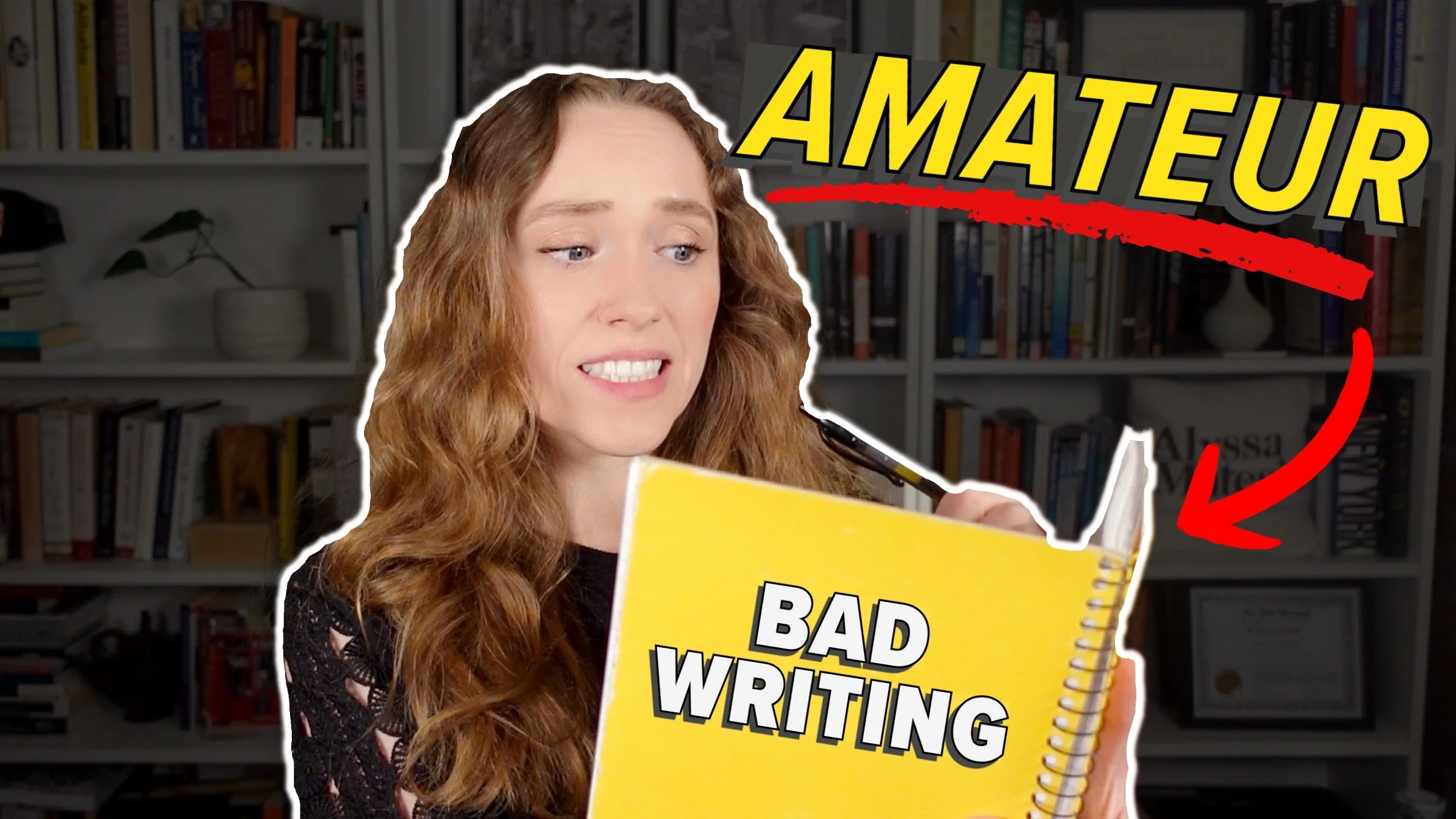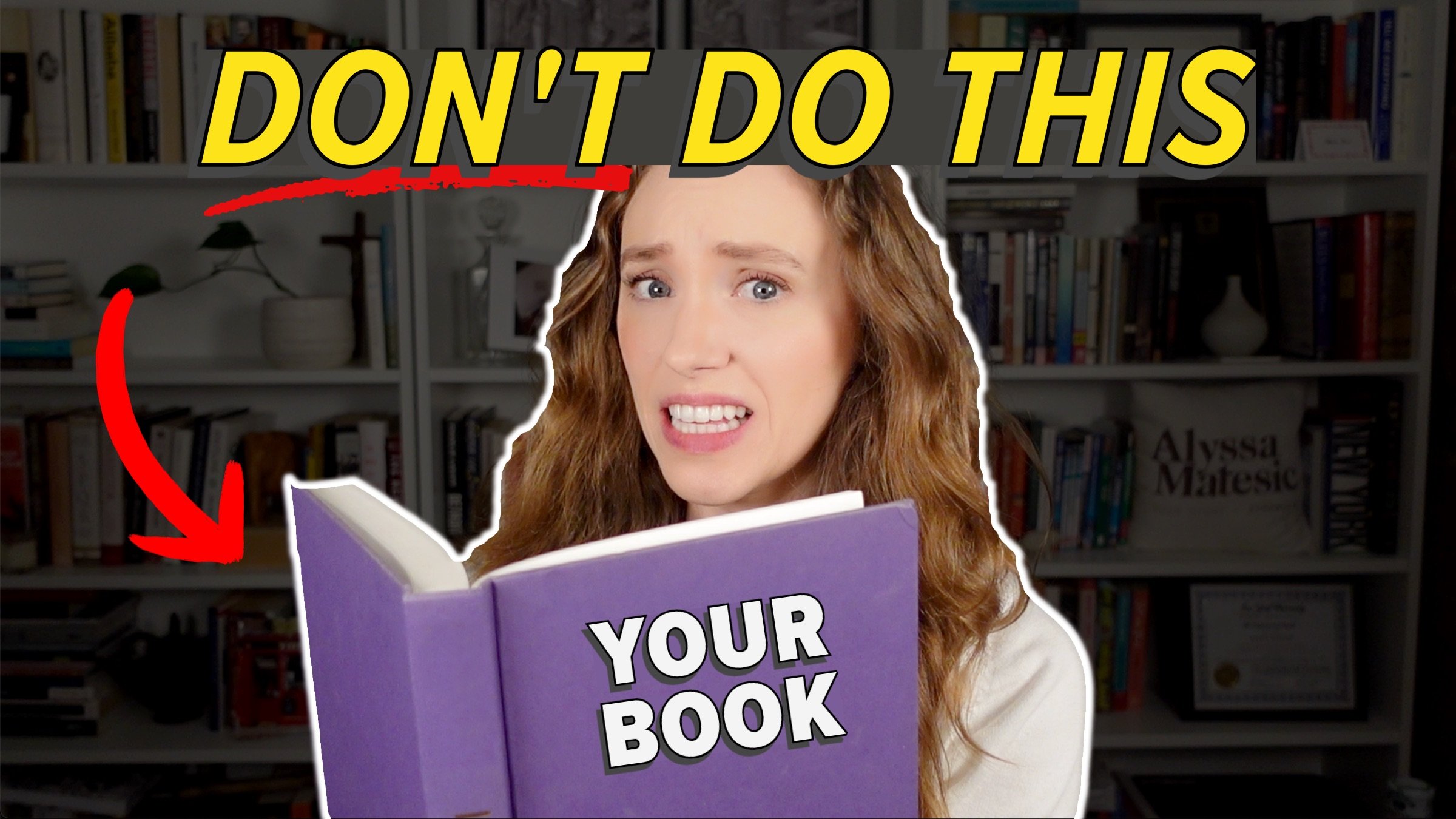7 Amateur Writing Mistakes to Avoid for a Stronger Manuscript
HIT PLAY OR READ THE POST BELOW:
I've edited hundreds of books over my career as a developmental editor, including New York Times bestsellers, and today I'm sharing the seven biggest mistakes I see amateur authors make in their novel manuscripts.
If you want a crash course in everything I've learned about writing over the past decade, you've come to the right place. We'll talk about why these issues can ruin your story, how to spot them in your own draft, and strategies to fix them fast.
1. Not Exploring the Protagonist’s Mind Enough
This is the most common problem that nearly all new writers make.
One of the fastest ways to lose your reader is to keep your protagonist's inner world locked away. The beauty of novels is that they grant us access to the protagonist's mind in a way that no other storytelling format does. When we're watching a film, show, or even a play, we don't have direct access to the character's thoughts and feelings — we have to infer them based on what we see.
But in a novel, readers don't just want to watch your character do stuff — they want to feel what it's like to be inside their mind as it's happening. That's why it's so important to show your protagonist's interiority on the page. We should feel what they feel and know what it's like to walk in their shoes.
When I get manuscripts that are too light on interiority, it's easy for me to tell — because I won't care about the protagonist. I'll watch them move through scenes, but I won't understand why they're doing what they're doing, or how they feel about everything that's happening. As a result, I feel nothing about the story, which causes me to disengage — the last thing you want as a writer.
How you convey your protagonist's interiority will depend on the point of view you choose for your story (which we'll get to in just a minute). But whether you're writing in first person or third person, we should have some access to their mind.
Here are the most important elements of your protagonist's inner world to illuminate for the reader:
First, their objective. What does your protagonist want? What are they working toward — and why? This is key to understanding the conflict that sets off their journey.
Their emotional responses. When something happens — a twist, a betrayal, a setback — we need to see their response, not just what happens next. Do they feel shock, shame, resentment, or even numbness? Show that on the page.
And finally, their decision-making process. We should understand how the decisions your character makes ladder up to their overarching objective. This applies both on a smaller scene level — why did they go to the library? why did they call their friend? — and on a broader plot level — why did they choose to accept that job offer? why did they break up with their partner?
If your manuscript is all plot and no interiority, you're missing half of the story — and the reader isn't likely to get emotionally invested in your protagonist's journey. Make sure we're given enough access to their mind to understand why the events of the story matter to them.
2. Having an Inconsistent Point of View
I'm incredibly passionate about this one and discuss it with nearly all of my editing clients — because it can completely disrupt the reader's experience of the story.
If you're writing in third person, listen up — because I see so many authors confuse close third person and omniscient narration. And this slip-up can require significant revisions to fix. I want you to get ahead of all of that before it even becomes an issue.
Here's what I see all the time: writers think they're writing in omniscient narration, so they switch character perspectives whenever they feel like it, willy-nilly. But really, they're writing in close third person — and head-hopping when they shouldn't be.
If the first three chapters all follow Sarah's POV, then we get a couple of lines from Mike's POV, then switch back to Sarah's POV for another chapter, then briefly dip into Jack's POV for a couple of paragraphs — that's not intentional omniscient narration. That's haphazard head-hopping, which disorients the reader and feels like whiplash.
I'm not saying you can't write omniscient narration. There are plenty of novels that do so successfully — including several classic and canonical works. But if you choose to write omniscient narration, make sure it's clear to the reader that we have a narrator who's mediating the entire story, and that the distance created by omniscient narration is warranted.
More times than not, the novel should really be reorganized into rotating close third person narration, where we switch between POVs on a consistent cadence.
That brings me to my next tip for POV: if you have multiple POVs, make sure every single one is justified and belongs in the story. If we follow one POV for just a single scene and that character doesn't get a full arc, maybe that scene would be better delivered from a more prominent character's perspective. You should also be sure to balance the POVs so it doesn't feel like we're neglecting one storyline for too long.
To really nail down POV, ask yourself:
Am I writing in omniscient, close third person, or first person?
Am I consistent throughout the entire novel? (There are cases where you can mix POVs — but those are the exception.)
Is every POV I include necessary to tell this story?
If I have multiple POVs, is the story balanced between them?
If you suspect you have a POV issue in your story, nail that down first — before working through any of these other issues — because it's going to make a huge difference in your next draft.
3. Info-Dumping
This mistake is a dead giveaway for an amateur writer — and once you see it, you can't unsee it.
Nothing kills your narrative momentum faster than an info dump. The worst part is that info dumps typically come at the beginning of a novel, which is the most fragile time for you to retain your reader's attention — and they're likely going to put the book down before the story even starts.
Perhaps your novel takes place in a fantasy world, and you write a 20-page prologue containing all of the necessary historical context you want the reader to know upfront before they enter the story. I hate to say it, but you've got to cut it — because readers don't want to read a textbook. They want to read a story. And stories should always be anchored in scenes.
Instead of unloading all the backstory about your world and your characters in one lengthy passage, you want to weave that information into the scene action as your characters go about their world and interact with one another in it. That will give you opportunities to provide the necessary exposition.
For example, instead of an info-dump passage telling us that the kingdom has been at war for the past decade, show your character stepping over rubble or hearing gunfire in the distance. Perhaps they interact with a shop owner who mentions that they opened their store ten years ago, when the war first broke out. That delivers all the same information to the reader without breaking the flow of the scene — and will be much more engaging to read.
And remember: we don't need all the exposition delivered to us upfront, right at the start of the story. If you do a good job hooking us into the story with intriguing action and conflict, we'll be curious enough to keep reading to learn more.
If a piece of exposition is not relevant to what a character is doing right now in a scene, then save it for later — when it does become relevant.
4. Refusing to Kill Your Darlings
This mistake is a mindset that you need to change if you're serious about making your story as strong as it can possibly be.
I know you love that funny side character who goes off on their own quest for a chapter. That flashback scene that shows the origins of a relationship. Ultimately, if these scenes feel like tangents rather than critical contributions to the plot — they have to go.
Learning how to ruthlessly edit your own work is one of the toughest skills for new authors to develop, but it's what sets professionals apart from amateurs. Killing your darlings isn't just about trimming fat here and there (though most first drafts are a lot longer than they need to be). Removing what doesn't belong in the story enables you to discover the true heart of it.
If your story doesn't really begin until 50 pages in, or your ending drags on for too long after the climax, or you have subplots or secondary characters that aren't adding anything — chances are, you need to make cuts.
You may very well have needed to write these scenes and characters to explore and discover your story. But once you have a draft that you're editing, it's time to zoom out, think critically about what your story really is about, and then cut everything that isn't serving that.
I like to think of writing a book like sculpting. You start with a raw block of marble — the first draft gives you the general shape. Then, killing your darlings is the process of chiseling away everything that isn’t the core story.
Here's a tip that makes killing your darlings a whole lot easier: create a "cutting room floor" document where you throw all the scenes that you remove. That way, nothing’s ever truly lost — and those deleted scenes could ultimately find new life in a future draft where they belong, or a new story altogether.
Still wondering what to cut? If parts of your novel feel too slow, boring, or are lacking emotional impact — this is where to look first.
5. Writing Weak Scenes
Every great scene is made up of three key elements: action, narrative, and dialogue.
Action is the choreography — what's literally happening in the scene. Narrative includes exposition and reflection from your POV character; it provides context and tells us how the character is perceiving what's going on. Dialogue illustrates the dynamics between characters and helps us understand their relationships.
All scenes should include at least two, if not all three, of these elements. But amateur writers typically lean too heavily on one of these elements in their scenes and neglect the others — which leads to the narrative feeling static and one-note.
For example, if you lean too heavily on action, the reader will crave more narrative to understand the implications of everything we see happen on the page. On the flip side, if you lean too heavily into narrative, the reader will crave more action and dialogue to understand what's physically happening and how the plot is progressing. If you have a scene that's all dialogue and nothing else, it'll become tiring to read, and the reader will crave seeing what's happening beyond what the characters are saying aloud to one another.
6. Not Thinking About Your Reader
This one is rarely talked about in writing circles, but it's so critical if you plan to publish your work one day.
Regardless of the publishing path you’re on, there comes a time when you have to realize that you're not just creating art for the sake of it — you're creating a product to sell to someone.
Amateur writers tend to focus inward: What do I want to say? What do I feel like writing about? These are important and valid questions, and you should always write for yourself first and foremost. But when you begin to think about publishing your story, it's time to flip the script and ask: What do my readers want to feel? What will keep them turning the pages?
The most successful authors I've worked with are constantly thinking about — and prioritizing — the reader's experience of their work, because they understand that the act of publishing is a business transaction.
That doesn't mean you have to write commercially if that doesn't suit your style. But you do have to write intentionally and understand the market you're entering.
If you haven't yet defined your novel's genre, that will be a key step in this process — so you can ensure you're delivering the experience that readers of that genre will be looking for.
If you're writing a thriller, your reader wants a fast pace, constant tension, and a satisfying payoff. If you're writing romance, the reader wants swoon-worthy chemistry. If you're writing literary fiction, your reader wants thought-provoking themes and emotional resonance.
Professional authors understand who their reader is and what they want — and they deliver on that experience without sacrificing the story they want to tell.
7. Neglecting the Revision Process
And finally, probably the last thing you want to hear — but you need to: neglecting the revision process.
Once you write "The End" on your draft, it's really just the beginning. Revision is where the magic happens — where you transform your messy first draft into an incredible story.
No one — not even your favorite author — produces a perfect first draft. They put in the work to revise and strengthen it, draft after draft after draft.
But here's where a lot of new authors get revisions all wrong: they start by line editing. They tinker with sentences, swap out adjectives, adjust comma placements. But if the entire structure of your story is broken, then polishing each individual sentence is a waste of your time and energy at this point.
First, you need to focus on fixing those big-picture issues. By watching this video, you're already well ahead of the game and understand what foundational mistakes to watch for in your story — but how do you actually do it?
If you don't know where to start with revisions, I recommend using a technique called reverse outlining. After finishing your draft, open up a new document and write down what happens in every scene. You'll essentially have a long, detailed summary of every scene in your book. If you have multiple POVs, color-code the reverse outline so you can see which scenes follow which storylines.
Now, once you have the reverse outline, you can evaluate all those big-picture elements. Are your POVs balanced? Are there outlier scenes that don't belong? Are there places where the conflict dies and the momentum slows down?
Go back into your draft and fearlessly edit it. Start a new document if you have to — which will help you see what’s not already on the page that needs to be.
I'm not going to sugarcoat it: revision is hard, hard work. But it's also where you discover what your story really is, and how powerful it can become. That's why I fell in love with editing — and I promise, the revision process can even become fun if you embrace it.
Ready to Level Up Your Writing?
If you're making any of these mistakes, don't worry — that just means you're doing the work of writing. And the best part is that all of these issues are completely fixable.
The difference between amateur writers and pros is not talent — it's awareness and a willingness to improve.
And if you're curious about what your manuscript might be missing, download my free Story Self-Assessment Worksheet below, which breaks down all the elements I evaluate in manuscripts I’m editing and will help you see where you can improve.
Thanks so much for reading — and happy writing!






